Features
Resident Evil (2002): Survival Horror Refined
Twenty years on, Resident Evil Remake is still one of GameCube’s finest achievements.
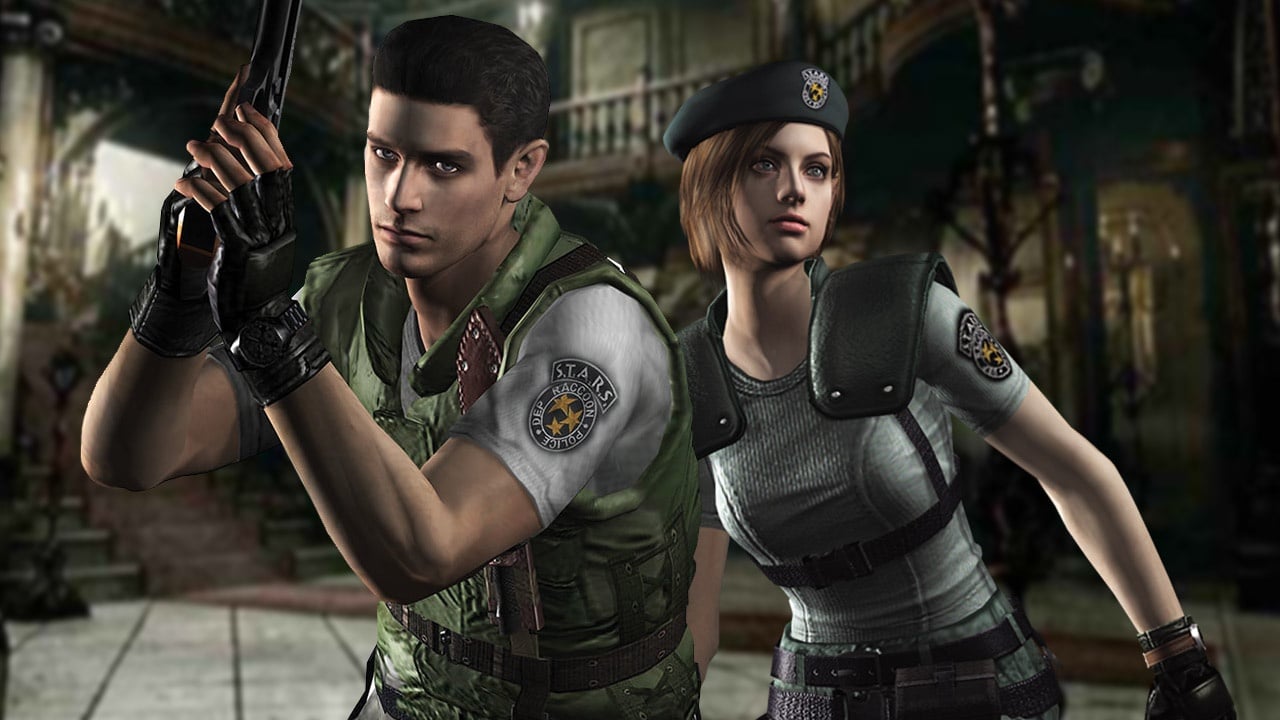
As tense as the game can get, the original Resident Evil is rooted in an unmistakable campiness. For every genuine scare, cheesy voice acting and an almost nonsensical script are always waiting around the corner. But this is all part of Resident Evil’s charm. There’s a B movie quality that feels authentic to the horror genre without taking away from the scares. Between the goofy voice direction is a genuinely scary game that uses player interactivity to build tension. The PlayStation’s limitations coupled with a lackluster localization simply meant the full scope of RE’s terror couldn’t be completely realized. That all changed a mere decade later, however. Utilizing the power of the Nintendo GameCube, Resident Evil (2002) seized an opportunity to make the original’s vision a reality.
“Fear can’t kill you, but…”
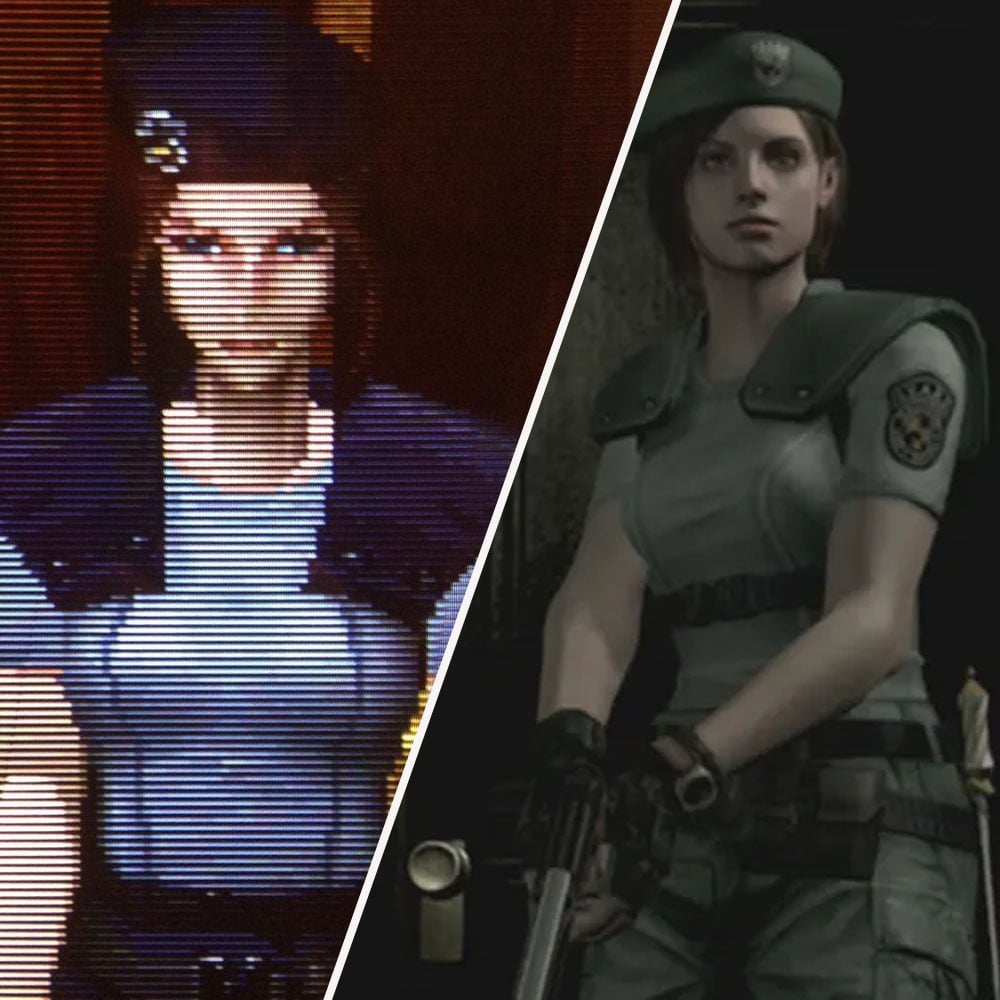
Resident Evil Remake is pure horror from top to bottom. Anything even remotely silly has been scaled back to match the new darker and more mature tone. Reserved, tonally appropriate performances replace the original’s outlandish voice direction. Several comedic lines have been reworked (“You were almost a Jill sandwich” becomes “you would’ve fit nicely into a sandwich“) or outright removed (“He’s sleeping with the ultimate failure”), ensuring dialogue seldom undercuts the story’s inherent horror. Most impactfully, the original aesthetic has been completely overhauled.
Resident Evil 1 needs bright lighting and a vibrant color palette to look as good as it does while properly telegraphing visual information. The Spencer Mansion’s walls are lined in an assortment of garish wallpaper and, with the exception of a few puzzle sections, virtually every single room is well lit even if it doesn’t make sense. The PlayStation original couldn’t afford to be as visually realistic as the developers may have wanted. Resident Evil on the GameCube kneels to no such graphical limitations.
The most obvious difference between the PlayStation and GameCube graphical styles is that Resident Evil Remake places a heavy emphasis on dynamic lighting. Large stretches of the Spencer Mansion are now basked in darkness, dimly lit rooms often the best you’ll get. Light is used sparingly, and only when it makes sense. The dining room balcony is now drearily dark, relying on lightning flashes through the windows to cast light in. Corridors and hallways are tense strides into the unknown, every corner robbing you of a precious light source. Sometimes the only source of light in a room is a candle or dull lightbulb illuminating what little it can.

The remake’s sophisticated lighting grounds the Spencer Mansion within a deeper sense of reality, but it’s the environmental nuances that fully round out the setting. Small details complement RER’s darkness to set an unnerving atmosphere where everything adds to the horror. Fog covers the outer grounds as the wind howls around you. Dust particles in the moon’s glow speak to the mansion’s lifelessness. Shadows dance along the walls where fire flickers. Real-time reflections in mirrors and water make you second-guess every step.
It’s also just worth noting how downright beautiful the game looks, especially on an original GameCube. Pre-rendered backgrounds are visually outstanding. Every single screen has had an immense amount of care put into them so that nothing looks out of place. The mansion’s wallpaper is worn down with damage–some fresh, others weathered by time. Surprisingly detailed paintings adorn the walls in elegant taste. Furniture looks genuinely lived in and used. Desks are covered in notes, books, and personal knickknacks. Bedding is often torn apart, and sheets are scattered on the floor. The Aqua Ring’s walls are coated in moisture. The woods are dense in a sea of thick trees. Resident Evil Remake is nothing short of gorgeous.
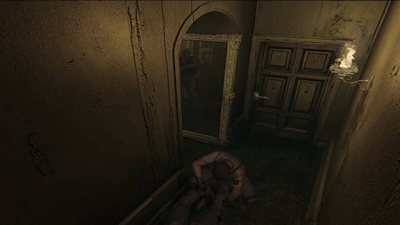
Dynamic camera angles take the presentation a step further by playing with perspective. Each screen is its own vignette brimming with life. The cemetery behind the hall leads to a deep crypt chaotically illuminated by a blazing furnace. The forest pathway twists itself after every corner, warping your sense of direction as you navigate what’s otherwise a straight path forward. The entry into the library forces you to walk past the windows where Yawn breaks in through, only spawning the boss after you’re out of sight. You hear a crash off-screen and suddenly a massive snake is slithering towards you. RER’s camera angles make already tense scenarios even more intense.
The sound design adds another layer of horror to the experience and is arguably the scariest part of the game. Zombies groan in the distance while they shamble as best they can. Hunter footsteps are unsettlingly wet and their guttural growls immediately warn you of danger. The mansion creaks as you walk through its oldest wings. Your footsteps echo in large halls. Thunder booms in the darkest rooms. Grass rustles and insects jitter as you explore the outside. Shusaku Uchiyama’s soundtrack remixes the original’s already great tracks and makes them profoundly creepier, scoring the experience with some of the series’ best music.

In spite of so many presentational enhancements, the remake’s controls remain thankfully faithful to the original. Movement is still handled via the series’ classic tank controls, playing off camera angles perfectly. Holding up on the analog stick moves your character in whichever direction they’re facing; left and right turn; and down makes them back up. This slower control scheme works in tandem with RER’s claustrophobic level design and methodical enemy placement to craft truly scary gameplay. It’s not as if there aren’t the quality of life additions, either.
Players can quick-turn on a dime, which is now often necessary to outrun some of the fattest enemies. Defensive items that don’t take up inventory space have been added to Chris and Jill’s equipment pool, triggering an automatic counter if players are grabbed by an enemy. Stairs no longer need to be examined, you can simply walk up them. The menu map color codes rooms you’ve fully explored in green and incomplete rooms in red, offering some direction for those struggling with exploration.

Resident Evil Remake’s game design builds on the best qualities of the original. The tension that made the first Resident Evil so good is amplified to an extreme degree. Doors are kept as loading screens, preserving the tense transitions that defined the original mansion. Clever enemy placement forces you to listen carefully for noise and pay attention to shadows on the walls. The east wing doorknob by the safe room will actually break off if you open it too many times, making you reroute through the main hall. The Aqua Ring set piece has been heavily remixed, requiring you to solve a time-sensitive puzzle while Neptune breaks down the glass keeping you separated. A few screens even feature a stalker character ala Mr. X and Nemesis, sending Lisa Trevor after you in tight spaces.
Resource management is still very much in play, if not more important than it was the first time around. You couldn’t afford to kill everything in the original game and you certainly can’t in the remake. Ammo isn’t necessarily scarce, but there are a greater variety of enemies, they take a fair bit of damage to kill, and zombies who don’t die via headshot eventually revive if their bodies aren’t burned. Killing a zombie means committing to burning their body or risking another encounter. If revived, zombies become Crimson Heads–aggressively fast variants of the undead who rush you on sight and give chase until you either put them down or leave the room.
You have a fixed amount of time between killing a zombie and burning their body before they revive. Actually burning a zombie requires dosing them in kerosene and then setting them ablaze with a lighter (Jill can alternatively burn bodies with her grenade launcher). Kerosene is finite, however, and there are only a few refueling stations around the mansion. This adds another layer of decision-making to the zombie killing process. Sometimes you just can’t afford to burn another body. The Crimson Heads introduces a gameplay loop that builds familiarity with the level design by forcing you to remember where you’ve left any unburnt bodies and where to refuel.

RER’s level design on a whole improves on an already masterful setting. The Spencer Mansion is rearranged, but not to the point where it becomes unrecognizable. This is as much a reimagining as it is a sincere recreation of what was on the PS1. Areas have been expanded upon in a way to keep anyone intimately familiar with the original on their toes while maintaining a familiar quality. Changes to the original’s foundation make for richer gameplay. New rooms to navigate mean more enemies, which demands greater resource management from you. Crimson Heads force you to reroute and carefully consider who to kill, along with when & where. New content is on par in quality with, if not often better than, the original. The west wing expansion and forested outdoors naturally fit in.
Puzzles in particular undergo a massive makeover. While a few are left untouched (like the Moonlight Sonata portion of the goldcrest puzzle), others are changed extensively. Popping a red jewel inside the tiger statue drops a horde of snakes on top of you. The armor room now has you pushing statues in a set order instead of covering poisonous vents. The crest puzzle has been revamped from your entrance into the Guardhouse to an optional side quest that unlocks the Magnum. There are even new puzzles like the mural room which test your reflexes on a level the original never attempted.
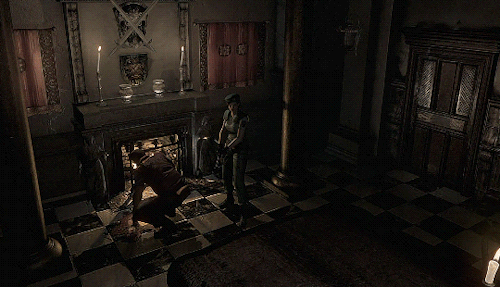
Like the mansion itself, RER’s story has a darker and more somber quality. Events play out with a seriousness that heightens the narrative’s stakes and urgency. Barry’s interactions with Jill are much more ambiguous, replacing his friendly charm with the realistic resolve a desperate man would have in his situation. Rebecca goes from plucky to borderline catatonic. Her original quirkiness is replaced with a weathered attitude that makes it clear she’s struggling to hold herself together (which makes sense considering the events of Resident Evil 0 means Rebecca has been awake for days in a high-stress situation for multiple days). Wesker isn’t (as) cartoonishly evil, setting a better foundation for the imposing conspirator he’d become by CODE: Veronica X and Resident Evil 5.
Along with fine-tuning the main cast, the remake adds in an overarching subplot through documents left behind by George Trevor–the mansion’s eccentric architect. His notes chronicle his and his family’s imprisonment following the mansion’s completion. George reflects on his attempts at solving his own puzzles, the peril he’s put his family in, and the eventual certainty of his doom. His only mercy is that he dies never knowing the horrors that befell his loved ones. Both experimented on, George’s wife dies while his daughter Lisa succumbs to infection and is warped into a grotesquerie who just wants her mommy. The Trevors add an unforgettable layer of sorrow to Resident Evil’s campaign.
“In the darkness lies your fears.“
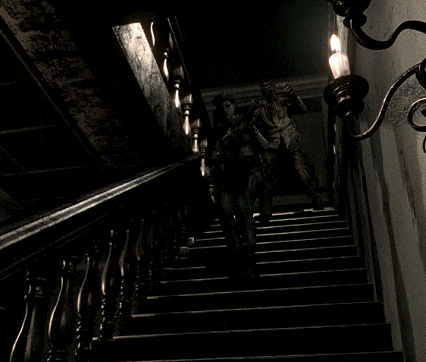
Resident Evil (2002) is a remake that serves not to replicate but to refresh its source material and offer a dynamic experience for veterans & newcomers alike. In this sense, RER stands just as much a companion piece, at its best when you come with an understanding of the PlayStation original. You can still enjoy RE1’s B-movie charm while indulging in the horror Capcom intended from the very beginning via the remake. So much has been reimagined, but Resident Evil’s identity remains firmly in place. Twenty years on, Resident Evil Remake is still one of GameCube’s finest achievements.

-

 Features3 weeks ago
Features3 weeks agoDon’t Watch These 5 Fantasy Anime… Unless You Want to Be Obsessed
-

 Culture3 weeks ago
Culture3 weeks agoMultiplayer Online Gaming Communities Connect Players Across International Borders
-

 Features3 weeks ago
Features3 weeks ago“Even if it’s used a little, it’s fine”: Demon Slayer Star Shrugs Off AI Threat
-

 Features1 week ago
Features1 week agoBest Cross-Platform Games for PC, PS5, Xbox, and Switch
-

 Game Reviews3 weeks ago
Game Reviews3 weeks agoHow Overcooked! 2 Made Ruining Friendships Fun
-

 Guides4 weeks ago
Guides4 weeks agoMaking Gold in WoW: Smart, Steady, and Enjoyable
-

 Features2 weeks ago
Features2 weeks ago8 Video Games That Gradually Get Harder
-

 Game Reviews3 weeks ago
Game Reviews3 weeks agoHow Persona 5 Royal Critiques the Cult of Success
-

 Features2 weeks ago
Features2 weeks agoDon’t Miss This: Tokyo Revengers’ ‘Three Titans’ Arc Is What Fans Have Waited For!
-

 Features1 week ago
Features1 week agoThe End Is Near! Demon Slayer’s Final Arc Trailer Hints at a Battle of Legends
-

 Guides2 weeks ago
Guides2 weeks agoHow to buy games on Steam without a credit card
-
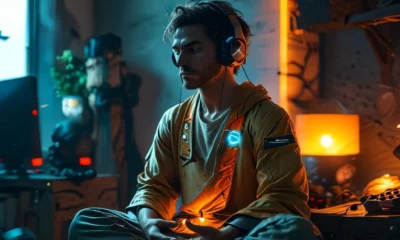
 Uncategorized2 weeks ago
Uncategorized2 weeks agoSleep Meditation Music: The Key to Unwinding



















